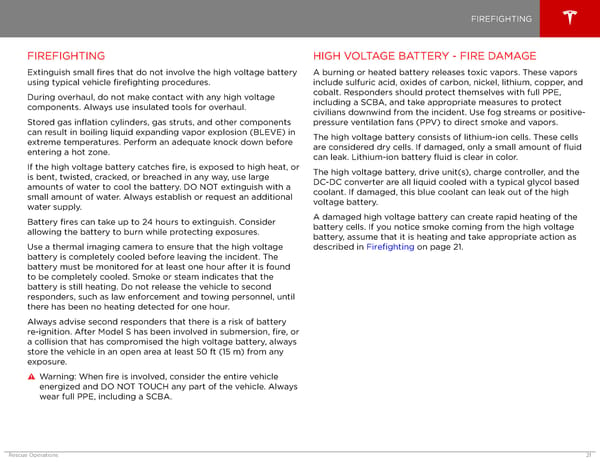FIREFIGHTING FIREFIGHTING HIGH VOLTAGE BATTERY - FIRE DAMAGE Extinguish small fires that do not involve the high voltage battery A burning or heated battery releases toxic vapors. These vapors using typical vehicle firefighting procedures. include sulfuric acid, oxides of carbon, nickel, lithium, copper, and During overhaul, do not make contact with any high voltage cobalt. Responders should protect themselves with full PPE, components. Always use insulated tools for overhaul. including a SCBA, and take appropriate measures to protect civilians downwind from the incident. Use fog streams or positive- Stored gas inflation cylinders, gas struts, and other components pressure ventilation fans (PPV) to direct smoke and vapors. can result in boiling liquid expanding vapor explosion (BLEVE) in The high voltage battery consists of lithium-ion cells. These cells extreme temperatures. Perform an adequate knock down before are considered dry cells. If damaged, only a small amount of fluid entering a hot zone. can leak. Lithium-ion battery fluid is clear in color. If the high voltage battery catches fire, is exposed to high heat, or The high voltage battery, drive unit(s), charge controller, and the is bent, twisted, cracked, or breached in any way, use large DC-DC converter are all liquid cooled with a typical glycol based amounts of water to cool the battery. DO NOT extinguish with a coolant. If damaged, this blue coolant can leak out of the high small amount of water. Always establish or request an additional voltage battery. water supply. Battery fires can take up to 24 hours to extinguish. Consider A damaged high voltage battery can create rapid heating of the allowing the battery to burn while protecting exposures. battery cells. If you notice smoke coming from the high voltage battery, assume that it is heating and take appropriate action as Use a thermal imaging camera to ensure that the high voltage described in Firefighting on page 21. battery is completely cooled before leaving the incident. The battery must be monitored for at least one hour after it is found to be completely cooled. Smoke or steam indicates that the battery is still heating. Do not release the vehicle to second responders, such as law enforcement and towing personnel, until there has been no heating detected for one hour. Always advise second responders that there is a risk of battery re-ignition. After Model S has been involved in submersion, fire, or a collision that has compromised the high voltage battery, always store the vehicle in an open area at least 50 ft (15 m) from any exposure. Warning: When fire is involved, consider the entire vehicle energized and DO NOT TOUCH any part of the vehicle. Always wear full PPE, including a SCBA. Rescue Operations 21
 Model S | 2016 Emergency Response Guide Page 21 Page 23
Model S | 2016 Emergency Response Guide Page 21 Page 23